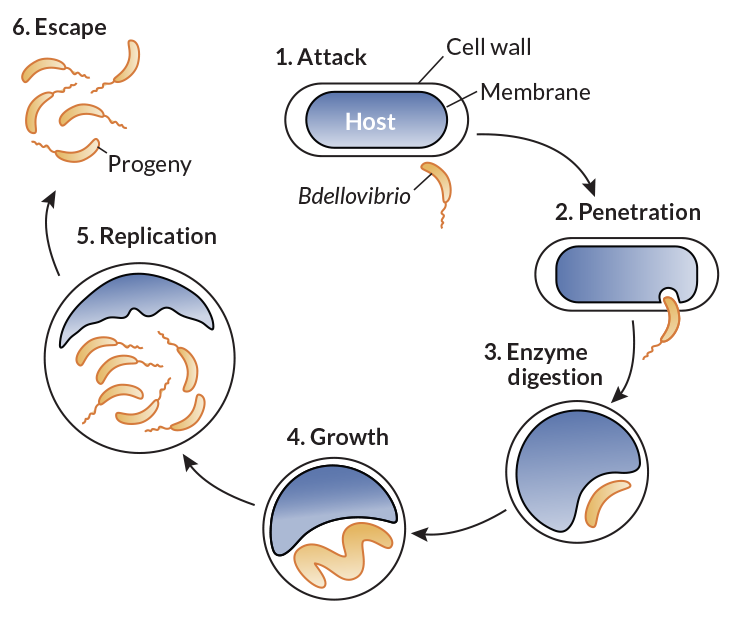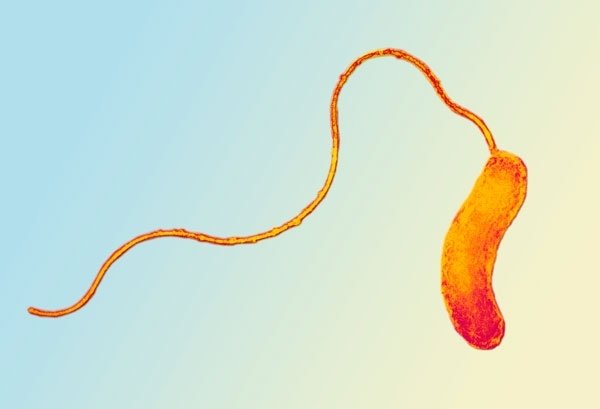The hunt is on: Bacteria that eat other bacteria
Introduction
Success in the bacterial world largely depends on your ability to get energy and raw materials. So, if something can be eaten it's a good bet that there's a least one bug out there eating it. This is why we have things like decomposition, fermented foods, and some infections. Bacteria themselves aren't off limits to being eaten by other bacteria and, sure enough, there are bacterial predators out there which use some pretty neat strategies to hunt their prey.
I'd like to tell you all about three of the most popular of these fierce little creatures.
Bdellovibrio and BALOS
Perhaps the most well-known and studied bacterial predators are from the genus Bdellovibrio and its close relatives, know affectionally as BALOs or "Bdellovibrio and like organsisms".1
Bdellovibrio uses its single flagellum (whip-like tail) to swim around while hunting its prey. When it locates a suitable victim, it goes into full-on attack mode. To get a feeling for what attack mode is like, picture an old-timey pirate movie. Bdellovibrio rams into the the outer part of the prey and deploys what are essentially grapples to hold fast. It then secretes enzymes to break down the outer cell membrane and thin cell wall of its victim and swims into the periplasmic space between the cell's outer wall and inner cell membrane. This strategy is probably one of the reasons that Bdellovibrio only targets Gram-negative organisms (they're the only ones with the appropriate cell wall structure). Bdellovibrio will then repair the outer wall and may either rest or continue its assault. More enzymes are secreted, breaching the inner cell membrane and allowing Bdellovibrio to eat up all of its prey's delicious cytoplasm, which is rich in energy, nutrients, and other metabolites.2

Image Source: A.R. Willis et al. (2016) Current Biology
Myxococcus - the bacterial Zerg
While Bdellovibrio is a lone pirate looking for plunder, Myxococcus xanthus prefers strength in numbers and hunts in a swarm often called a wolf pack.3
A single Myxococcus cell exudes enzymes which could theoretically and eventually break down prey, such E. coli, but when they team up watch out. Like many bacteria, Myxococcus moves using a gliding motion, but it uses a nice tweak to become a seriously effective predator. If two cells are next to each other, they coordinate their motion so that they tend to become aligned, move in same direction, and stay out of each other's way.4 At the large scale this means a colony becomes a swarm which roves around looking for prey, and when it finds some, there is not one, but a great many cells all working together to break down the prey, allowing the swarm to dine on delicious cytoplasm.
Vampirococcus
The last example isn't nearly as well studied, but it makes up for that by having an excellent name. So far as I know, Vampirococcus has only been observed in two freshwater lakes and it has not been isolated as a pure culture5. Technically a BALO, Vampirococcus is a little different than our friend Bdellovibrio. As best we can tell, mainly from electron microccopy, it attaches to the outside of its victim and somehow causes a breach in the cell wall and sucks its prey dry. It doesn't really enter they prey and it has a completely different shape than Bdellovibrio. Even more interesting, while Bdellovibrio is something of a generalist happy to dine on many Gram-negative bugs, Vampirococcus appears to attack only a few specific organisms. As far as science is concerned, no bacteria are members of the Belmont lineage, so Vampirococcus is here to stay.
Ecological roles and potential uses
It's a reasonable assumption that like most predators, these bacteria have a role in shaping the number and kinds of other species within their ecosystem. For some systems, it may even be the case that without these predators things would get seriously out of whack, much like deer population explosions in areas where wolves have been driven out.
In the realm of basic science, the distinctive behaviors of these bacteria make them good candidates for studying things like gene regulation, emergent group behavior, and chemical sensing and responses.
Some researchers are also interested in exploiting their behavior for specific applications. A major thrust of the research right now is using them to control the growth of other bacteria, like preventing biofilm formation7 on things like desalination membranes. It has been suggested that they may also be used in fighting infections. So far as I know, no one has made serious progress here8 - even if the human body were a suitable environment for these predators, there are issues with unintended consequences and delivery.
Conclusion
The wonderful diversity of the microbial world is exemplified but not encompassed by these tiny hunters. If there's a way to live, it's a safe bet that there are bacteria finding some neat way to do it and it is this versatility and adaptability which makes bugs such an endlessly fascinating subject.

You received a 10.0% upvote since you are not yet a member of geopolis.
To read more about us and what we do, click here.
https://steemit.com/geopolis/@geopolis/geopolis-the-community-for-global-sciences-update-3
If you do not want us to upvote and comment on your posts concerning earth and earth sciences, please reply stop to this comment and we will no longer bother you with our love ❤️
Hey, it is a fascinating topic, and you did very well in describing those bacteria. The language and length is appropriate. A good written, interesting scientifc post that should qualify for steemstem-curation (although there is no 100% certainty ofc^^).
A question that arises almost automatically: Are those bacteria able to tackle mammal cells as well?
More of the same please, left you a upvote and followed you.
Thanks for the feedback, language and length were the two things I was most concerned about.
Based on the way they attack cell walls, I'd be highly surprised if any of the BALOs attack mammalian cells. It's also pretty unlikely that Myxococcus itself would do so. I could imagine a different bug following a similar wolf pack strategy to attack single-celled non-bacteria and metazoa. Not sure if it would be a worthwhile strategy with large multicellular organisms like mammals.
@originalworks